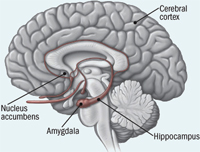Tuesday, 21 November 2017
Conceptual evolution in some explanations in neuroscience

This website and this blog have been around long enough now (over 15 years and nearly 7 years, respectively) to have witnessed the ongoing evolution and refinement of certain concepts in the neurosciences. We all know that science evolves, but it can be interesting to see how. That’s what I’d like to show today, using an example of conceptual evolution. This example relates to the amygdalae—the two almond-shaped groups of neuronal nuclei on either side of the brain that were associated with human fear reactions very early in the history of neuroscience. Indeed, studies such as those by Joseph LeDoux have shown that when a threatening stimulus is presented to rats or humans, the neurons in each amygdala in their brains become highly active.
But as brain-imaging studies became more common, they showed that the activity in someone’s amygdala could also increase in other situations as well (for example, when that person was extremely hungry or saw a loved one suffering). (more…)
Emotions and the Brain | No comments
Sunday, 25 September 2016
How Different Parts of the Brain Co-operate

Perhaps one of the hardest things to understand about the brain is the way that it is organized into networks. In this post, I will discuss a 2015 study, on the brain structures involved in delayed gratification, that makes this complex subject a bit easier to grasp. (more…)
Pleasure and Pain | No comments
Tuesday, 27 January 2015
Functions of the amygdala : more diverse than previously thought

Science in general, and neuroscience in particular, are constantly evolving. So even though our knowledge of a given brain structure may not have undergone a scientific revolution or a paradigm shift at any given time, when we compare what we know about it now with what we knew, say, 10 years ago, we may find that things have changed a lot. That’s certainly the case for the amygdala, a small but very important piece of the brain. And since we first described the amygdala on this website just about 10 years ago, we’d like to give you a little update now. (more…)
Emotions and the Brain | Comments Closed
Tuesday, 18 February 2014
Lasting Effects of Meditation
 A brain-imaging study published in the November 2012 issue of the journal Frontiers in Human Neuroscience seems to confirm past brain-imaging studies which found that meditation can help people pay better attention and manage stress more effectively. But the November 2012 study goes a bit further: it also shows that such measurable positive effects of meditation seem to continue even when the individual in question is not meditating. (more…)
A brain-imaging study published in the November 2012 issue of the journal Frontiers in Human Neuroscience seems to confirm past brain-imaging studies which found that meditation can help people pay better attention and manage stress more effectively. But the November 2012 study goes a bit further: it also shows that such measurable positive effects of meditation seem to continue even when the individual in question is not meditating. (more…)
The Emergence of Consciousness | Comments Closed
Tuesday, 6 August 2013
“Centres” of Cognitive Functions in the Brain: A Misleading Concept

The media nowadays often publish reports that scientists using brain-imaging technology have just discovered the brain’s “centre” for anger, jealousy, generosity, or some other specific emotion or cognitive function. But the idea of such a centre is, at best, an outrageous oversimplification, and at worst, completely misleading.
That is the argument made by Dr. William A. Cunningham in the February 2012 issue of the journal Current Directions in Psychological Science. His article deconstructs a very limited view of a part of the brain called the amygdala,which the popular press often describes as the brain’s “fear centre”. (more…)
Emotions and the Brain | 1 comment







